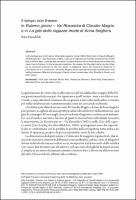Chapter Il tempo non lineare in Esterno giorno – Val Rosandra di Claudio Magris e in La gita delle ragazze morte di Anna Seghers
Abstract
In Anna Seghers’ short story, Gita delle ragazze morte (1943-1944) and in Claudio Magris’ Esterno giorno – Val Rosandra (1982), a group of high school friends and their trip on the eve of World War I provide the narrative nucleus around which individual micro-histories meet macro-history. In the proposed analysis, the reason for the deprivation is identified as an element common to the two texts. In Seghers’ story, the temporal distance is cancelled out in a continuum, whereas Magris’ story operates through multiplication and fading between different typologies of texts: novel, screenplay, film, Goethe’s Faust, and short story.


 Download
Download Web Shop
Web Shop